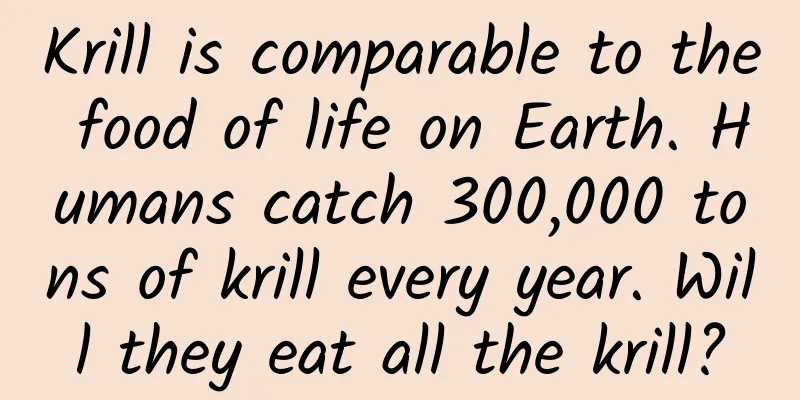Krill is comparable to the food of life on Earth. Humans catch 300,000 tons of krill every year. Will they eat all the krill?

|
Krill are like crops in the sea. A lot of them can be caught every year, and no human maintenance is required. Due to the huge number of krill, there is now a common view that krill will never be completely fished out by humans. In fact, this view is not very scientific. It can be clearly stated that the last animal that was thought to be impossible to be eaten forever was the passenger pigeon. However, after Europeans landed in North America, billions of passenger pigeons were eaten up in less than 100 years. The krill population is indeed huge, but they are not as tenacious as imagined. According to the Guardian, since the 1970s, in just 50 years, the number of krill has decreased by about 80%, which can be described as a sharp decline. Although this sharp decline is believed to be mainly caused by climate change, it is a fact that our catch is increasing every year while krill numbers are declining. Therefore, if nothing changes and the catch continues to increase, the krill will be "eaten up" sooner or later. The reason why krill populations are so large is actually very simple - they are the consumers at the bottom of the marine food chain and can directly eat the most abundant plankton in the ocean. They enjoy a huge amount of food, so their numbers naturally increase. These animals are quite interesting. Let’s learn about krill together. How many krill are there in the ocean? We do eat krill, but krill and the dried shrimps we usually talk about do not come from the same species of shrimp, and we eat very little krill directly. The dried shrimps we usually eat are animals of the genus Trimeresurus in the family Sphenopsidae in the order Decapoda (basically all the shrimps we usually eat are of the order Decapoda), and they can be caught without going to cold waters such as Antarctica, while krill belong to the order Euphausiaceae. Figure: Krill luminescence is considered a protective mechanism There are many species of krill in the order Euphausiaceae. One common feature of these krill is that they can glow. Perhaps this is how the name "krill" came from! The krill we usually refer to are basically Antarctic krill - they live in the Southern Ocean. This is one of the largest species on Earth and is also the most fished shrimp by us. Figure: Red dots indicate krill distribution In 2009, a scientific team calculated that the biomass of Antarctic krill reached 0.05 gigatons of carbon (Gt C), which is about the same amount as all humans today. However, their size is so small compared to humans, so you can imagine how large their population is. It is very difficult to count the number of Antarctic krill, so the error is often very large. The data available now show that the maximum number of Antarctic krill may reach 6 billion tons. During the breeding season, Antarctic krill can perform spectacular water shows, with 10,000 to 60,000 individuals per cubic meter of water, dyeing the entire sea red. Satellites in space can capture such scenes. Although there are indeed a lot of Antarctic krill, whether it is the part caught by humans or the part lost naturally, the amount of Antarctic krill eaten directly by humans is only a drop in the bucket. Antarctic krill is mainly used for aquaculture Since the Soviet Union discovered the value of Antarctic krill in 1972, the catch of Antarctic krill has been increasing every year. Now about 150,000 to 300,000 tons of krill are caught worldwide each year, most of which are Antarctic krill. Compared with the weight of 6 billion tons of Antarctic krill (the error of this 6 billion tons is very large, some statistics show that it is only about 125 million tons), it seems that the portion caught by humans is indeed very small. The photo above shows two types of "shrimp skin" that I took when I went to the supermarket to buy vegetables. I wonder if you can recognize which one is Antarctic krill? The answer is: the red one on the right is Antarctic krill! You will find that Antarctic krill is better than the shrimp on the left in terms of size and color, but the price is only half of that of ordinary shrimp. The reason is not only that the catch of krill is relatively large, but also that it is not particularly popular. Personally, I really don’t like the taste of krill, which is much saltier than ordinary shrimp, so I rarely choose to buy Antarctic krill. On the other hand, Antarctic krill are not particularly suitable as direct human food, and even if you buy them, it is not recommended to eat too much. This is because their shells contain fluoride, which is toxic if ingested in high concentrations. Therefore, the captured krill is not mainly for human consumption, but is mainly used as a protein supplement for aquaculture, which is why krill is often called "sea pasture". However, in recent years, krill processed products - krill oil has become very popular because it contains antioxidants such as astaxanthin, vitamins A and R, which are beneficial to the human body. Therefore, the krill catch has started to grow rapidly at an annual rate of about 12% since 2010. From this we can see that as long as we really want to eat them, the consumption is still very terrible. Marine animals consume more krill than thought In fact, compared with the natural loss of krill in the wild, the amount caught by humans is a drop in the bucket according to data. Since krill are the bottom consumers in the marine food chain, many marine animals and birds are krill-based, either eating them directly or eating animals that eat krill. It is well known that large baleen whales feed directly on krill by filter feeding, and it is believed that blue whales eat up to 8,000 kg of krill a day. But baleen whales are not the largest consumers of krill. The animals that eat the most krill are seals and squids, because krill is the main food source for these two animals. It is believed that these two animals eat 100 million tons of krill each year. All animals on the earth may eat 313 million tons of Antarctic krill every year, and the part caught by humans (about 250,000 tons per year) is not worth mentioning in front of these animals. Such data may be the reason why many people believe that it is impossible for krill to be completely caught by humans. However, people often overlook the damage to the marine ecology caused by our fishing, as well as the impact of global climate change caused by human activities on krill. Figure: Schematic diagram of the krill paradox The Krill Paradox There is a very famous paradox about Antarctic krill - the krill paradox, which refers to the fact that when people were frantically hunting whales and the number of whales plummeted, people found that the number of krill also decreased. This fact is puzzling, as whales eat krill, and without whales the krill population also decreases. In fact, the reason is very simple. The food sources of whales are very broad, and krill is just one of them. However, the feces discharged by whales can affect the growth of plankton in the entire ocean. With fewer whales, there is less plankton, which means there is less food for krill to eat, so their numbers naturally decrease. It is impossible to eat all the passenger pigeons, and the gradual destruction of their habitat is the key to their extinction. At present, it seems that krill are following in their footsteps. at last The number of living things is always limited, but human desires are unlimited, so don't think that you can never eat all the animals and can catch them at will. The number of Antarctic krill is now decreasing much faster than expected, and the main reason is believed to be the accelerated melting of Antarctic glaciers. Regardless of the reason, if krill are allowed to decline sharply, many animals will starve and their numbers will decrease, which is a terrible process. Source: Weird Luo |
>>: [Creation and Cultivation Program] The Chinese sturgeon appeared in the market. Is it illegal?
Recommend
There is a lot of sand on the earth, and there are even more stars in the universe. How many galaxies are there in the universe?
How much sand is there on Earth? This is a questi...
Level 3 emergency response initiated! Heavy rain + thunderstorm + strong wind! These areas should be on guard →
The Central Meteorological Observatory continued ...
RongCloud CTO Yang Pan: Geek Online 2020 Programming Challenge allows developers to take the center stage
[51CTO.com original article] Recently, the first ...
How do lifestyle apps make money? Duitang, RiRiZhu, and Oxygen have something to say
Share a private recipe, help people choose a suit...
What kinds of data are mainly analyzed for SEM optimization? How do novice SEM users perform data analysis?
SEM is the abbreviation of Search Engine Marketin...
In the rainy season, cities turn on the "sea-viewing mode"? "Sponge" makes cities "water-absorbent"!
In recent years, many cities have turned on the s...
Tesla adjusts prices again: Model S and Model X drop by 8,000 yuan in China
Following the significant price cut of Model 3 in...
How much does it cost to customize the Qianxinan luggage app? Price inquiry for customized luggage app in Qianxinan
The launch of mini programs has brought convenien...
Detailed explanation of WeChat business agent model | 3 core agent models revealed
I have to say that’s a great question and one I’m...
How to design SEM account structure from 0 to 1?
Account structure is a difficult problem for begi...
The rise of the “leaseback model”: a new variant of cash loans?
At the end of last year, after the regulation of ...
App promotion tips: eight ways to tap into iOS channels
Question 1: I don’t know where to tap into the iO...
Scientists unveil Ebola virus's 'replication machine'
In September this year, the Ebola outbreak reappe...
A collision of ideas caused by code review
[[236712]] At the team's iteration review mee...
A collection of copywriting works taking advantage of Thanksgiving is freshly released, and a large number of copywriting works are heartwarming and comforting!
Thanksgiving Day originally refers to an ancient ...









